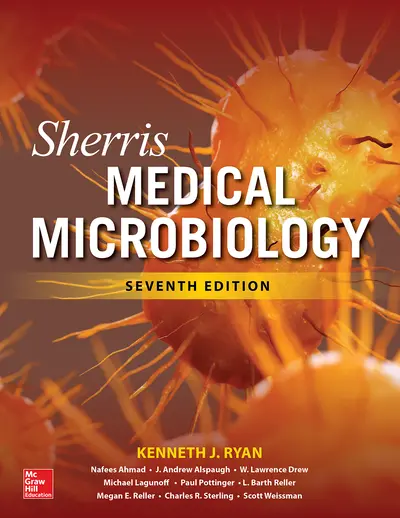My Account Details

ISBN10: 1259859819 | ISBN13: 9781259859816

Step 1 . Download Adobe Digital Editions to your PC or Mac desktop/laptop.
Step 2. Register and authorize your Adobe ID (optional). To access your eBook on multiple devices, first create an Adobe ID at account.adobe.com. Then, open Adobe Digital Editions, go to the Help menu, and select "Authorize Computer" to link your Adobe ID.
Step 3. Open Your eBook. Use Adobe Digital Editions to open the file. If the eBook doesn’t open, contact customer service for assistance.
The most dynamic, comprehensive, and student-friendly text on the nature of microorganisms and the fascinating processes they employ in producing infections disease
A Doody’s Core Title for 2021!
For more than a quarter-of-a-century, no other text has explained the link between microbiology and human disease states better than Sherris Medical Microbiology, Seventh Edition. Through a vibrant, engaging approach, this classic gives readers a solid grasp of the significance of etiologic agents, the pathogenic processes, epidemiology, and the basis of therapy for infectious diseases.
Part I of Sherris Medical Microbiology opens with a non-technical chapter that explains the nature of infection and the infection agents. The following four chapters provide more detail about the immune response to infection and the prevention, epidemiology, and diagnosis of infectious disease. Parts II through V form the core of the text with chapters on the major viral, bacterial, fungal, and parasitic diseases. Each of these sections opens with chapters on basic biology, pathogenesis, and antimicrobial agents. No other text clarifies the link between microbiology and human disease states like Sherris
- 57 chapters that simply and clearly describe the strains of viruses, bacteria, fungi, and parasites that can bring about infectious diseases
- Explanations of host-parasite relationship, dynamics of infection, and host response
- A clinical cases with USMLE-style questions concludes each chapter on the major viral, bacterial, fungal, and parasitic diseases
- All tables, photographs, and illustrations are in full color
- Clinical Capsules cover the essence of the disease(s) caused by major pathogens
- Margin Notes highlight key points within a paragraph to facilitate review
- In addition to the chapter-ending case questions, a collection of 100 practice questions is also included
PART I: Infection
1 Infection—Basic Concepts
2 Immune Response to Infection
3 Sterilization, Disinfection, and Infection Control
4 Principles of Laboratory Diagnosis of Infectious Diseases
5 Emerging and Reemerging Infectious Diseases: Emergence and Global Spread of Infection
PART II: Pathogenic Viruses
6 Viruses—Basic Concepts
7 Pathogenesis of Viral Infection
8 Antiviral Agents and Resistance
9 Respiratory Viruses
10 Viruses of Mumps, Measles, Rubella, and Other Childhood Exanthems
11 Poxviruses
12 Enteroviruses
13 Hepatitis Viruses
14 Herpesviruses
15 Viruses of Diarrhea
16 Arthropod-Borne and Other Zoonotic Viruses
17 Rabies
18 Retroviruses: Human T-Lymphotropic Virus, Human Immunodeficiency Virus, and Acquired Immunodeficiency Syndrome
19 Papilloma and Polyoma Viruses
20 Persistent Viral Infections of the Central Nervous System
PART III: Pathogenic Bacteria
21 Bacteria—Basic Concepts
22 Pathogenesis of Bacterial Infections
23 Antibacterial Agents and Resistance
24 Staphylococci
25 Streptococci and Enterococci
26 Corynebacterium, Listeria, and Bacillus
27 Mycobacteria
28 Actinomyces and Nocardia
29 Clostridium, Bacteroides, and Other Anaerobes
30 Neisseria
31 Haemophilus and Bordetella
32 Vibrio, Campylobacter, and Helicobacter
33 Enterobacteriaceae
34 Legionella and Coxiella
35 Pseudomonas and Other Opportunistic Gram-negative Bacilli
36 Plague and Other Bacterial Zoonotic Diseases
37 Spirochetes
38 Mycoplasma
39 Chlamydia
40 Rickettsia, Ehrlichia, Anaplasma, and Bartonella
41 Dental and Periodontal Infections
PART IV: Pathogenic Fungi
42 Fungi—Basic Concepts
43 Pathogenesis and Diagnosis of Fungal Infections
44 Antifungal Agents and Resistance
45 The Superficial and Subcutaneous Fungi: Dermatophytes, Malassezia, Sporothrix, and Pigmented Molds
46 The Opportunistic Fungi: Candida, Aspergillus, the Zygomycetes, and Pneumocystis
47 The Systemic Fungal Pathogens: Cryptococcus, Histoplasma, Blastomyces, Coccidioides, Paracoccidioides
PART V: Pathogenic Parasites
48 Parasites—Basic Concepts
49 Pathogenesis and Diagnosis of Parasitic Infection
50 Antiparasitic Agents and Resistance
51 Apicomplexa and Microsporidia
52 Sarcomastigophora—The Amebas
53 Sarcomastigophora—The Flagellates
54 Intestinal Nematodes
55 Tissue Nematodes
56 Cestodes
57 Trematodes
Infectious Diseases: Syndromes and Etiologies
Practice Questions In USMLE Format
Index
Need support? We're here to help - Get real-world support and resources every step of the way.